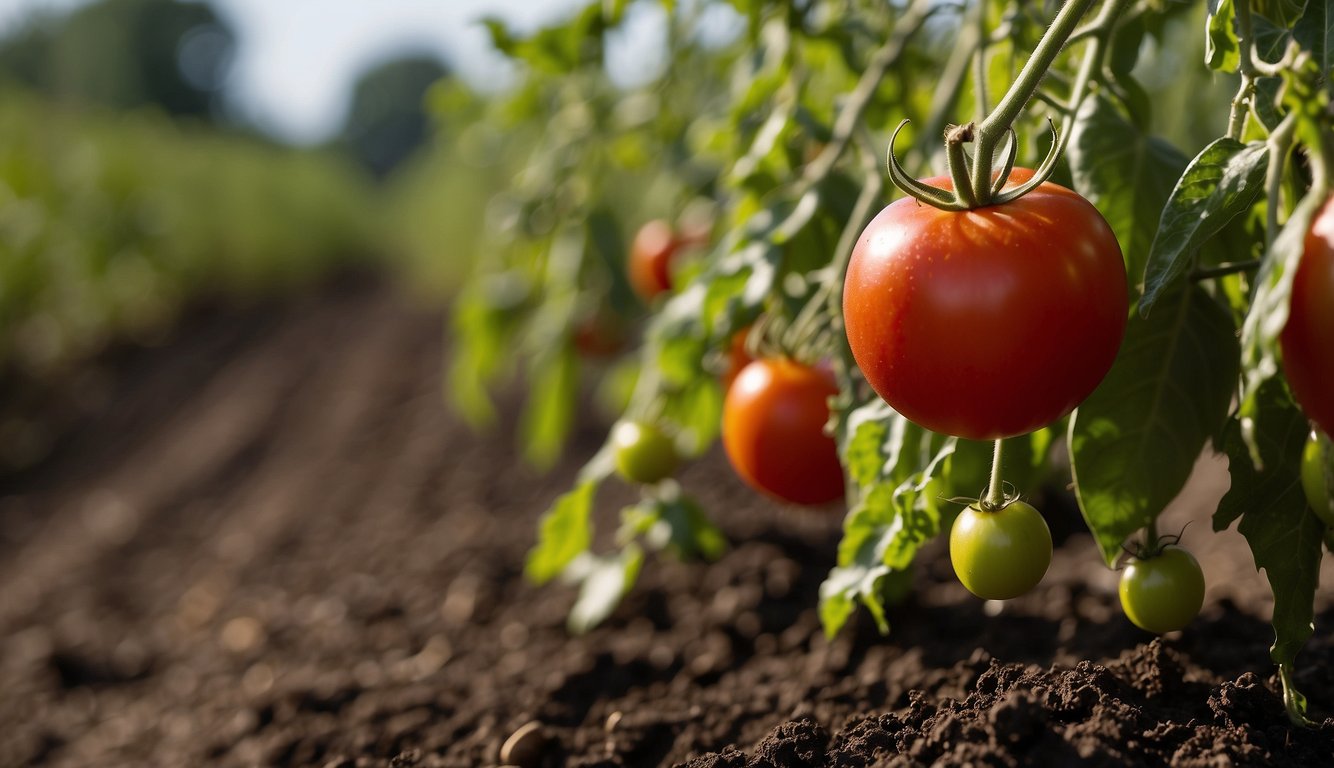TheHerbProf.com is a treasure trove of knowledge for those interested in natural healing and herbal remedies. The website is run by Paul Johnston MD. A naturopathic who has not only received extensive education in the field but also has personal experience in self-healing.
Tomatoes are a popular garden crop because of their versatility and taste. However, tomato plants are susceptible to various issues, including water wilt. This condition is caused by a lack of water, which results in the plant’s leaves and stems drooping. If left untreated, the plant may eventually die.
As a gardener, it’s important to be able to identify the symptoms of tomato water wilt. The first sign is usually wilting leaves, which may appear yellow or brown. The plant’s stems may also become soft and weak. If you suspect your tomato plant is suffering from water wilt, it’s important to take action immediately to save the plant.
To prevent water wilt in tomato plants, it’s important to ensure they receive sufficient water. Tomatoes require consistent watering, especially during hot, dry weather. However, overwatering can also cause issues, so it’s important to strike a balance. Additionally, planting tomatoes in well-draining soil and providing adequate drainage can also help prevent water wilt.
Understanding Tomato Water Wilt
As a tomato plant owner, it is important to understand the various diseases that can affect your plants. One of the most common diseases is tomato water wilt. This disease can cause your tomato plants to wilt, become limp, and eventually die. In this section, I will explain the symptoms, causes, and differences between water wilt and other wilt diseases.
Symptoms of Water Wilt
The first symptom of water wilt is wilting of the tomato plant leaves. The leaves will appear limp and may start to curl inward. As the disease progresses, the leaves will turn yellow and eventually die. In severe cases, the entire plant may wilt and die.
Causes of Water Wilt
Water wilt is caused by a lack of water in the soil. When the soil is too dry, the roots of the tomato plant cannot absorb enough water to keep the plant healthy. This can be caused by a variety of factors, including underwatering, drought, or poor soil quality.
Water Wilt vs. Other Wilt Diseases
It is important to note that water wilt is different from other wilt diseases that can affect tomato plants. For example, bacterial wilt is caused by a bacteria and can cause yellowing leaves and discolorations on the stem. Fusarium wilt, on the other hand, is caused by a fungus and can cause yellowing leaves and brown discolorations on the stem.
Water wilt is a common disease that can affect tomato plants. By understanding the symptoms and causes of this disease, you can take steps to prevent it from affecting your plants. Make sure to water your plants regularly and monitor the soil moisture levels to ensure that your plants stay healthy and strong.
Irrigation and Water Management

As tomato plants require a consistent supply of water, proper irrigation and water management are crucial for their growth and productivity. In this section, I will discuss some of the best practices for watering tomatoes and how to avoid common watering mistakes.
Proper Watering Techniques
The best way to water tomato plants is through drip irrigation or soaker hoses. These methods deliver water directly to the root zone, minimizing water wastage and promoting healthy plant growth. Overhead watering can cause the leaves to become wet, which can lead to fungal diseases.
When watering, it’s important to apply enough water to reach the root zone. A good rule of thumb is to water until the top 6-8 inches of soil are moist. However, be careful not to overwater, as this can lead to waterlogging and root rot.
Overwatering and Underwatering
Overwatering and underwatering are common mistakes that can affect the health of tomato plants. Overwatering can lead to waterlogged soil, which can suffocate the roots and cause them to rot. Signs of overwatering include yellowing leaves, wilting, and stunted growth.
On the other hand, underwatering can cause the soil to dry out, which can stress the plant and affect its growth. Signs of underwatering include wilted leaves, dry soil, and slow growth.
Watering Schedule Optimization
To optimize the watering schedule, it’s important to monitor the soil moisture level regularly. Tomatoes require consistent moisture, so it’s best to water deeply and infrequently rather than shallowly and frequently. A good watering schedule is to water once or twice a week, depending on the weather and soil conditions.
In times of drought, it’s important to provide enough water to keep the soil moist. Mulching around the base of the plant can help retain soil moisture and reduce water evaporation.
Proper irrigation and water management are crucial for the growth and productivity of tomato plants. By following proper watering techniques, avoiding overwatering and underwatering, and optimizing the watering schedule, you can ensure your tomato plants receive the right amount of water and thrive.
Soil and Nutrient Factors
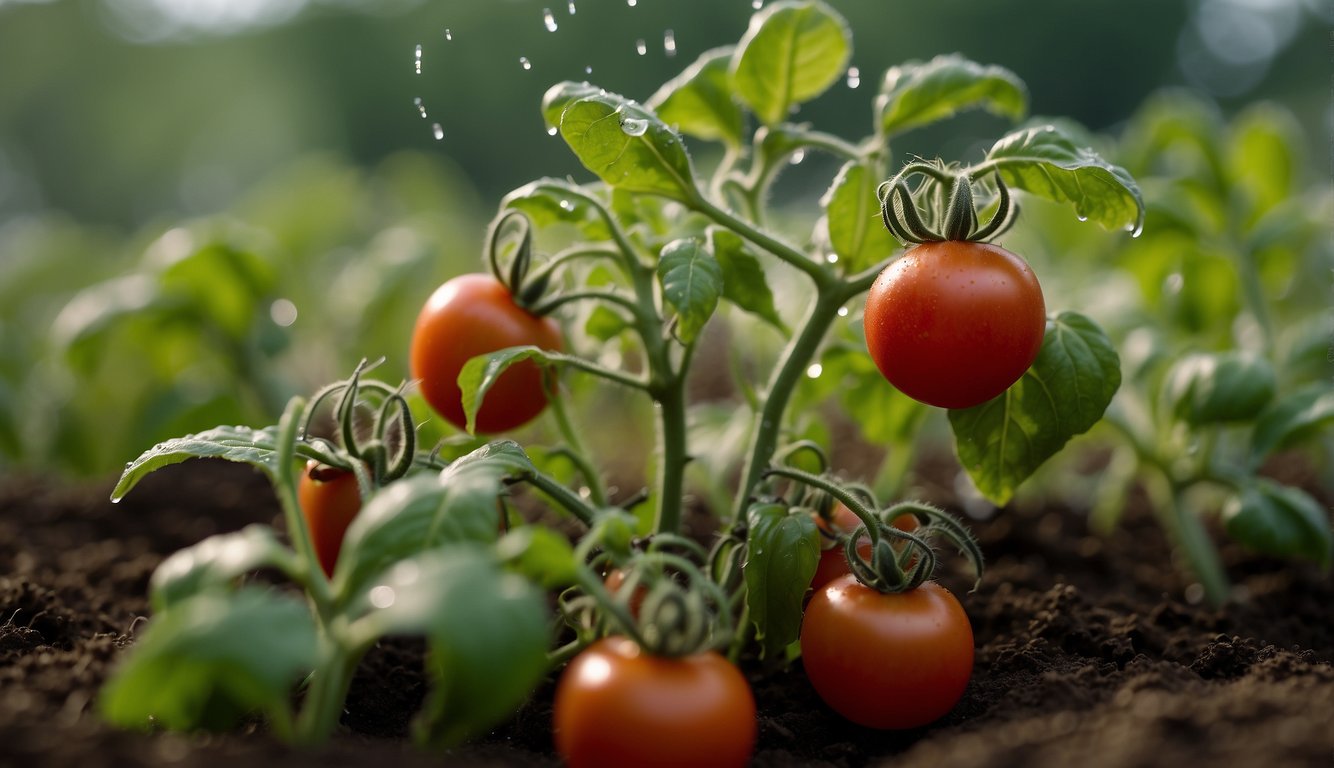
Soil Conditions and Wilt
As a tomato plant grows, it requires a well-draining soil with a pH level between 6.0 and 6.8. Poor soil drainage can lead to waterlogged soil, which can cause the roots to rot and lead to wilt. Additionally, soil that is too compacted can prevent roots from accessing water and nutrients, leading to wilt.
Fusarium wilt, a fungal disease that affects tomato plants, can also be present in the soil. This disease causes the leaves of the plant to wilt and turn yellow. If you suspect that your tomato plant has Fusarium wilt, it is important to remove the plant and dispose of it properly to prevent the spread of the disease to other plants.
Nutrient Availability and Plant Health
Tomato plants require a variety of nutrients to grow and remain healthy. Nitrogen, phosphorus, and potassium are the three primary macronutrients that tomato plants need in order to thrive. If any of these nutrients are lacking in the soil, it can lead to wilt.
In addition to macronutrients, tomato plants also require micronutrients such as calcium, magnesium, and iron. A deficiency in any of these micronutrients can also lead to wilt.
Compost and Soil Amendments
Adding compost and other soil amendments can help improve soil quality and nutrient availability, which can help prevent wilt in tomato plants. Compost can improve soil structure, increase water retention, and provide a source of organic matter for beneficial microorganisms.
Other soil amendments such as bone meal, blood meal, and fish emulsion can provide additional nutrients that tomato plants need to grow and remain healthy. It is important to follow the instructions on the package when applying these amendments to avoid over-fertilizing, which can also lead to wilt.
By ensuring that your tomato plants have the proper soil conditions and nutrient availability, you can help prevent wilt and ensure a healthy harvest.
Disease Identification and Management
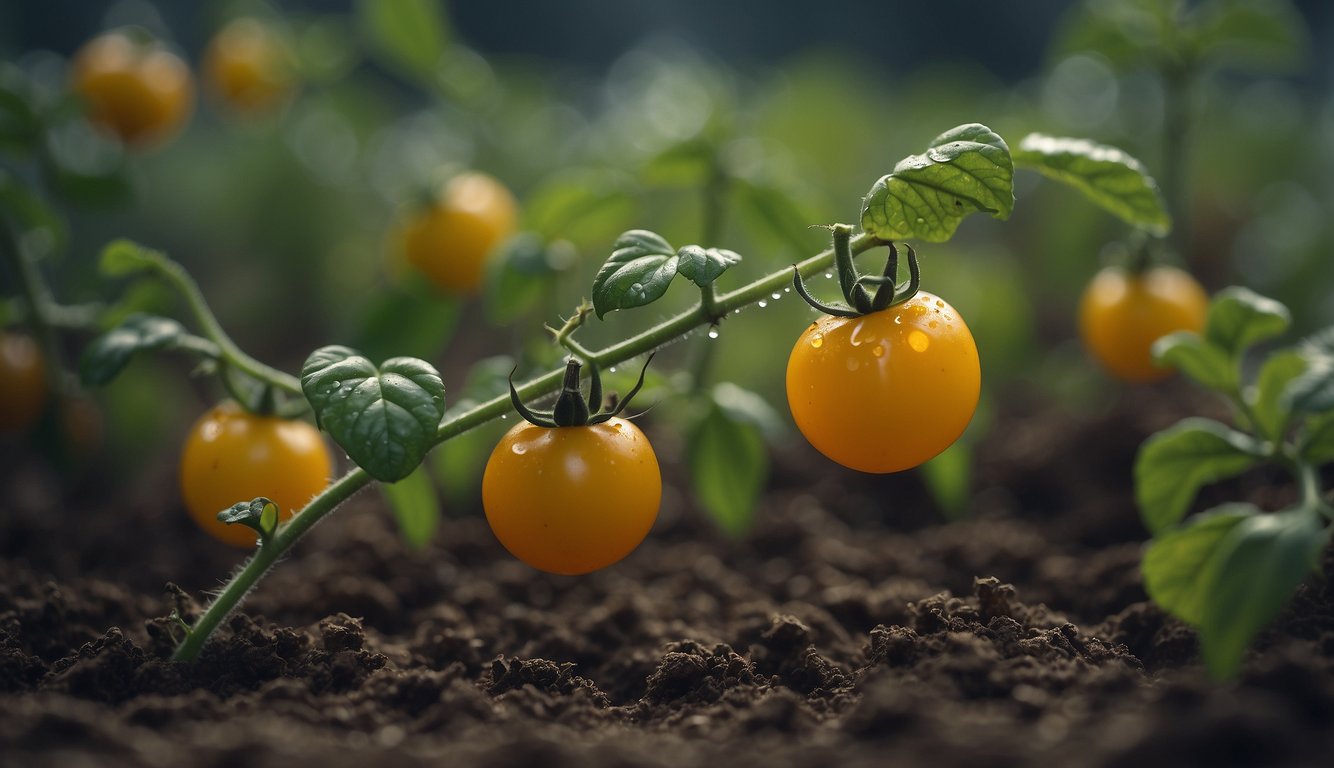
Tomato water wilt is a serious disease that can cause significant damage to tomato plants. It is important to be able to identify the different types of wilt diseases and take appropriate measures to manage them.
Fusarium Wilt
Fusarium wilt is caused by the fungus Fusarium oxysporum f. sp. lycopersici, which enters the plant through the roots. The fungus then spreads to the vascular system, causing the plant to wilt and eventually die. Symptoms of Fusarium wilt include yellowing and wilting of the lower leaves, followed by wilting of the entire plant. To prevent the spread of Fusarium wilt, remove infected plants and avoid planting tomatoes in the same location for at least three years.
Verticillium Wilt
Verticillium wilt is caused by the fungus Verticillium dahliae, which also enters the plant through the roots. The fungus then spreads to the vascular system, causing the plant to wilt and eventually die. Symptoms of Verticillium wilt include yellowing and wilting of the lower leaves, followed by wilting of the entire plant. To prevent the spread of Verticillium wilt, remove infected plants and avoid planting tomatoes in the same location for at least three years.
Tomato Spotted Wilt Virus
Tomato spotted wilt virus is a viral infection that is transmitted by thrips. Symptoms of tomato spotted wilt virus include brown or black spots on the leaves, yellowing and wilting of the plant, and stunted growth. To prevent the spread of tomato spotted wilt virus, use insecticides to control thrips and remove infected plants.
Bacterial Wilt and Fungal Diseases
Bacterial wilt is caused by the bacterium Ralstonia solanacearum, which enters the plant through the roots. The bacterium then spreads to the vascular system, causing the plant to wilt and eventually die. Symptoms of bacterial wilt include yellowing and wilting of the lower leaves, followed by wilting of the entire plant. To prevent the spread of bacterial wilt, remove infected plants and avoid planting tomatoes in the same location for at least three years.
Fungal diseases, such as root rot and other fungal wilt diseases, can also cause wilting of tomato plants. To prevent the spread of fungal infections, avoid overwatering and ensure proper drainage. Use fungicides to control fungal infections and remove infected plants.
It’s important to be able to identify the different types of wilt diseases and take appropriate measures to manage them. By following the above guidelines, you can prevent the spread of these diseases and ensure healthy tomato plants.
Pest and Environmental Stress Factors

As a tomato grower, I know how frustrating it can be to see your plants wilt and die. There are many factors that can contribute to tomato plant stress, including pests and environmental factors. In this section, I will discuss common pests affecting tomato plants and environmental stresses that can cause plant response.
Common Pests Affecting Tomato Plants
Tomato plants are susceptible to a variety of pests that can cause damage and stress to the plant. Some of the most common pests include thrips, stalk borers, aphids, and caterpillars. Thrips are tiny insects that feed on the leaves and flowers of tomato plants, causing them to curl and distort. Stalk borers are caterpillars that bore into the stem of the plant, causing wilting and death. Aphids are small insects that feed on the sap of the plant, causing yellowing and stunted growth. Caterpillars can also cause damage to the plant by chewing on the leaves and fruit.
Environmental Stresses and Plant Response
Environmental stresses can also cause tomato plants to wilt and die. Temperature is one of the most important factors affecting plant growth and development. High temperatures can cause wilting and death, while low temperatures can slow down growth and reduce yields. Overwatered tomato plants can also suffer from stress, as too much water can lead to root rot and other diseases. Sunflowers and black walnut trees are allelopathic plants that can release chemicals into the soil, which can inhibit the growth of other plants, including tomatoes. Finally, infected plants can also spread diseases to healthy plants, causing them to wilt and die.
In summary, there are many factors that can contribute to tomato plant stress, including pests and environmental factors. As a tomato grower, it is important to be aware of these factors and take steps to prevent and manage them. By providing your plants with the right conditions and protecting them from pests and diseases, you can ensure a healthy and productive crop.
Preventive Measures and Resistant Varieties
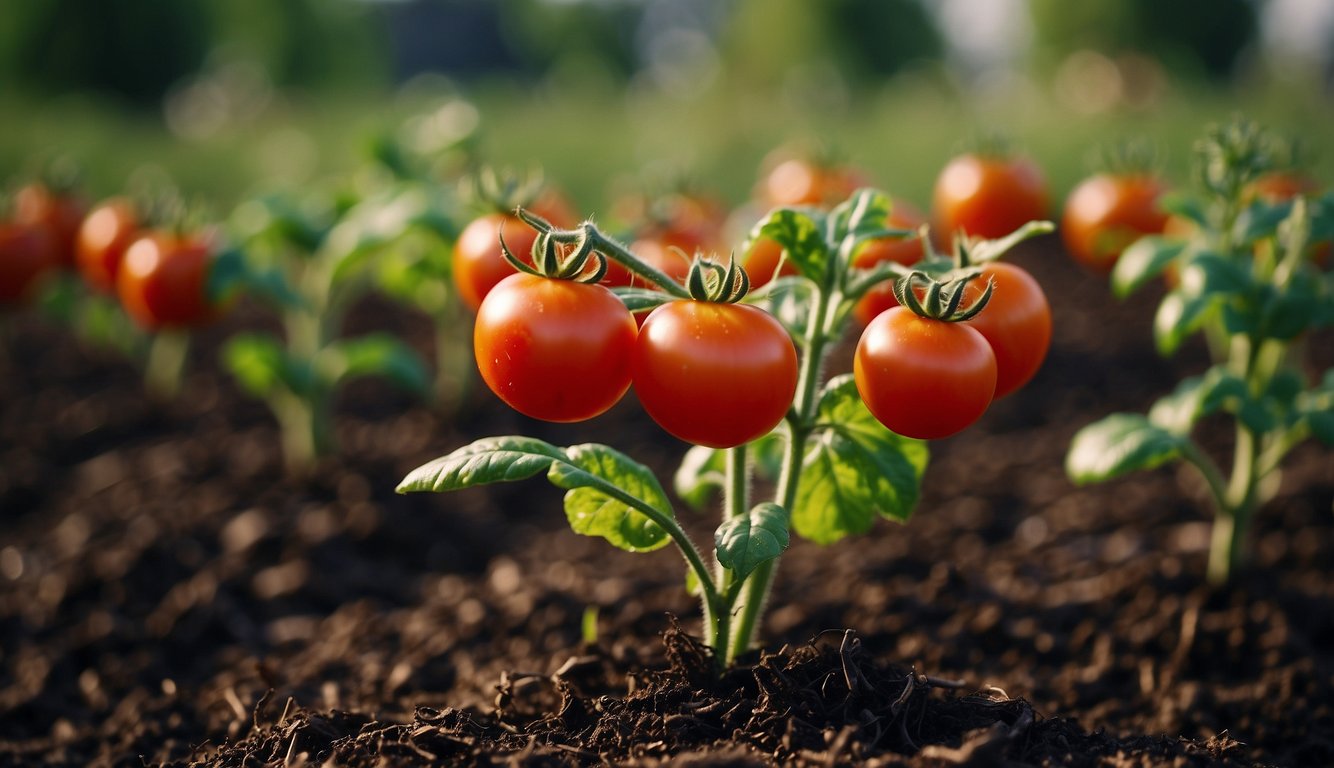
Cultivating Resistant Tomato Varieties – Tomato Water Wilt
As a gardener, I know that one of the best ways to prevent tomato wilt is to cultivate resistant varieties. There are many tomato varieties that are resistant to bacterial wilt, such as ‘Mountain Fresh Plus’, ‘Defiant’, and ‘Mountain Merit’. These varieties have been bred to be resistant to the bacteria that causes wilt, which means that they are less likely to die from the disease.
When selecting tomato varieties, it’s important to look for ones that are resistant to wilt. This will help prevent the disease from taking hold in your garden. You can find a list of resistant varieties online or at your local nursery.
Cultural Practices to Prevent Wilt
In addition to cultivating resistant tomato varieties, there are also cultural practices that can help prevent wilt. One of the most important things you can do is to make sure your tomato plants are getting enough sun. Tomato plants need full sun to thrive, so make sure they are planted in an area that gets at least 6-8 hours of sunlight per day.
Another important cultural practice is to rotate your crops. This means planting tomatoes in a different area of your garden each year. This can help prevent the buildup of bacteria in the soil, which can cause wilt.
Finally, it’s important to make sure your tomato plants are healthy and well-nourished. This means fertilizing them regularly and making sure they are getting enough water. Overwatering can actually make wilt worse, so make sure to water your plants only when necessary.
While tomato wilt can be a serious disease, there are many steps gardeners can take to prevent it. By cultivating resistant tomato varieties and following good cultural practices, you can help ensure that your tomato plants stay healthy and productive.
Advanced Topics in Tomato Cultivation – Tomato Water Wilt
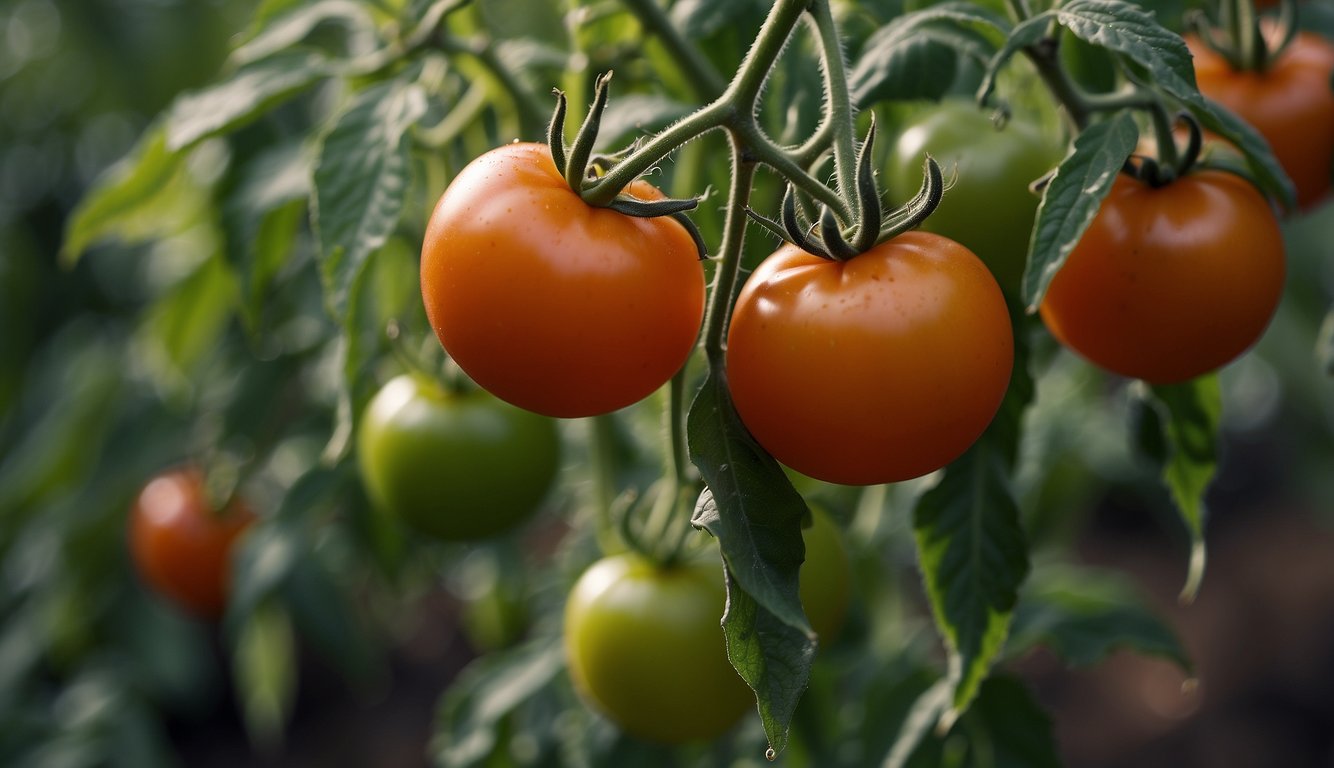
As a seasoned tomato farmer, I have learned that cultivating healthy tomato plants requires more than just planting and watering. In this section, I will explore advanced topics in tomato cultivation that can help you grow strong and disease-resistant tomato plants.
Breeding for Disease Resistance
One of the most effective ways to combat tomato plant wilting and other diseases is by breeding for disease resistance. This involves selecting tomato varieties that are naturally resistant to diseases such as root-knot nematodes, white mold, and southern blight. By doing so, you can reduce the risk of your plants getting infected and improve their overall health.
When selecting tomato varieties for breeding, it is important to consider their resistance to other nightshade vegetables such as eggplants, peppers, and potatoes. This is because these vegetables are susceptible to many of the same diseases as tomatoes, and planting them in close proximity can increase the risk of disease transmission.
Innovative Watering Systems – Tomato Water Wilt
Under watering is a common cause of tomato plant wilting and yellow leaves. However, over watering can also be detrimental to plant health, as it can lead to stunted growth and circle spots on the leaves. To avoid these issues, you can implement innovative watering systems that ensure your plants receive the right amount of water.
One such system is drip irrigation, which delivers water directly to the roots of the plants. This not only conserves water but also reduces the risk of disease transmission by minimizing the amount of water that comes into contact with the leaves. Another option is using self-watering containers, which have a reservoir that holds water and allows the plants to absorb it as needed.
Breeding for disease resistance and implementing innovative watering systems are two advanced topics in tomato cultivation that can help you grow healthy and robust tomato plants. By taking these factors into consideration, you can reduce the risk of disease and ensure that your plants thrive.
Tomato Water Wilt
Today, we’re diving into the world of Tomato Water Wilt. It’s a tricky issue, but don’t worry, we’ve got this!
Firstly, what is it? Well, Water Wilt is a condition where your tomato plants wilt due to overwatering. Yes, too much love can be a bad thing!
But fear not! The solution is simple – water less. Tomatoes like well-drained soil. So, let the soil dry out a bit between waterings.
And here’s a pro tip! Mulch your plants. It helps retain moisture and prevents overwatering. Plus, it keeps those pesky weeds at bay!
So, next time you’re tending to your tomatoes, remember – less is more when it comes to water!
For more gardening wisdom, do visit the website theherbprof.com. Keep those tomatoes happy, folks!
References – Tomato Water Wilt
Little Herb Encyclopedia, by Jack Ritchason; N.D., Woodland Publishing Incorporated, 1995
The Ultimate Healing System, Course Manual, Copyright 1985, Don Lepore
Planetary Herbology, Michael Tierra, C.A., N.D., Lotus Press, 1988
Handbook of Medicinal Herbs, by James A. Duke, Pub. CRP Second Edition 2007
The Complete Medicinal Herbal, by Penelope Ody, Published by Dorling Kindersley
Check the Following Articles!
How to Make Eggs Last Longer: Simple Tips and Tricks
Fruit Bushes That Grow in Shade: Guide to Shade-Tolerant
Do Rubber Trees Like to Be Root Bound?
Frequently Asked Questions – Tomato Water Wilt
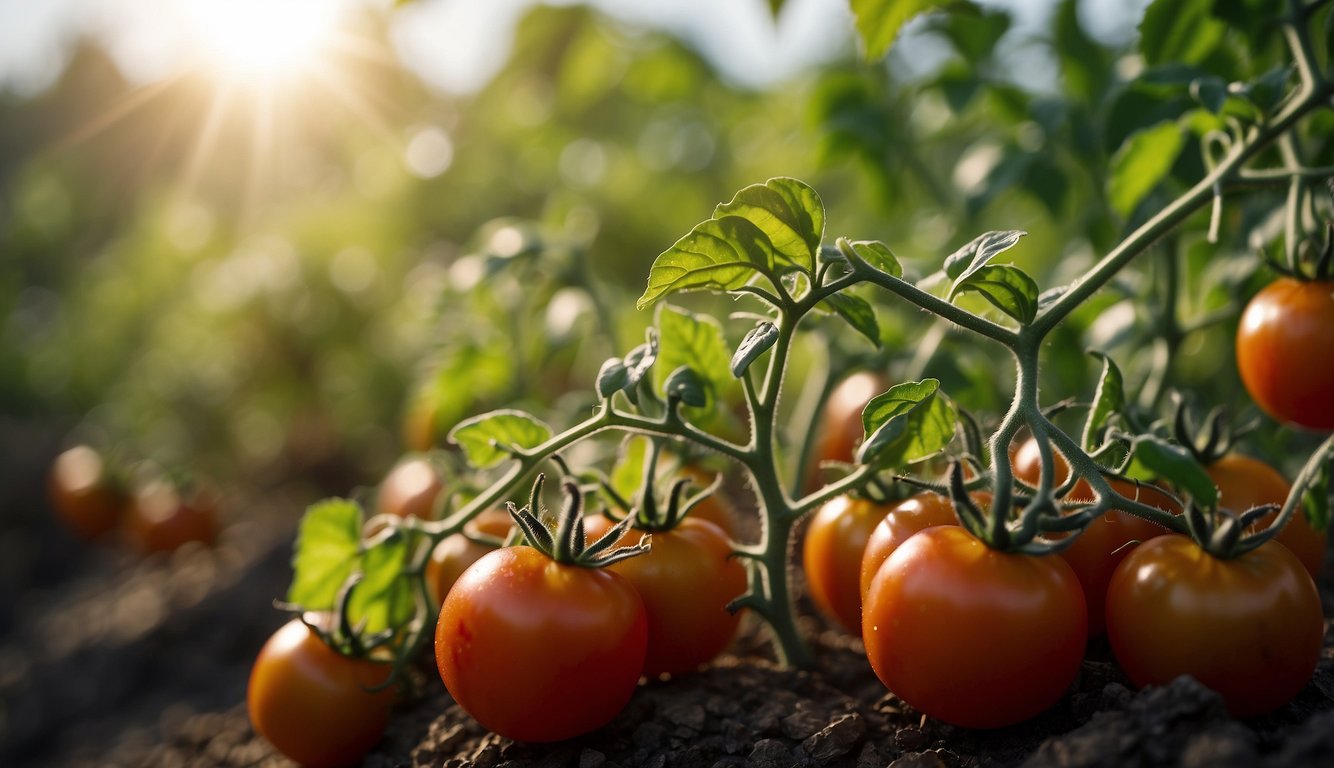
What are the common causes of wilt in tomato plants?
Tomato plants can wilt due to several reasons, including under or overwatering, fungal or bacterial diseases, pests, extreme temperatures, or poor soil quality. The most common cause of wilt in tomato plants is due to a lack of water. When the soil is too dry, the plant cannot absorb enough water, causing the leaves to droop and wilt.
What are the symptoms of tomato wilt disease?
Tomato wilt disease can cause the leaves of the plant to wilt and turn yellow. The stems may also become discolored and start to rot. The disease is caused by a fungus that lives in the soil and can be spread through contaminated soil or water. Infected plants should be removed and destroyed to prevent the spread of the disease.
How can you treat tomato plants affected by water wilt?
If your tomato plants are affected by water wilt, the first step is to water them thoroughly. You should also ensure that the soil is well-draining to prevent water from accumulating around the roots. If the plant is severely wilted, you can try to revive it by placing it in a bucket of water for a few hours. However, if the plant is too far gone, it may not recover.
Is it possible for a tomato plant to recover after wilting?
Yes, it is possible for a tomato plant to recover after wilting if the cause of the wilt is identified and addressed promptly. If the plant has wilted due to a lack of water, watering it thoroughly and providing it with adequate water in the future can help it recover. However, if the plant has wilted due to a disease or pest infestation, it may be difficult to save.
Why are my tomato plant leaves drooping and curling?
Tomato plant leaves can droop and curl due to several reasons, including over or underwatering, pests, diseases, or extreme temperatures. Overwatering can cause the roots to rot, while underwatering can cause the leaves to wilt. Pests and diseases can also cause the leaves to curl and droop.
What steps should be taken when a tomato plant wilts after repotting?
When a tomato plant wilts after repotting, it is usually due to shock. To help the plant recover, you should water it thoroughly and place it in a shaded area. You should also avoid fertilizing the plant until it has fully recovered. If the plant does not recover after a few days, you may need to repot it again or consider replacing it.
